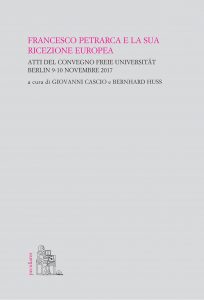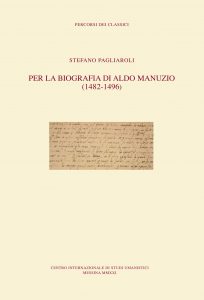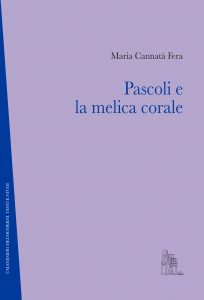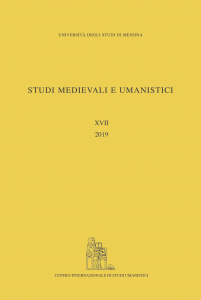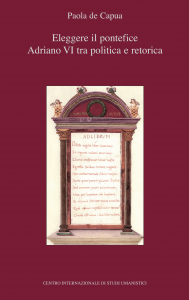
XVIII (2020)
Messina, Centro Internazionale di Studi Umanistici, 2020, 408 pp., tavv. VIII; 25 cm.
ISSN 2035-3774
€ 80
SOMMARIO
Vincenzo Fera, Archeologia di Valchiusa: «Chiare, fresche et dolci acque»
Stefano Rocchi, Accursiana I. Il ciclo epigrammatico della Fuggerkapelle ad Augsburg
LA TRASMISSIONE DEI TESTI GRECI E LATINI DAL MANOSCRITTO ALLA STAMPA.
Atti del convegno, Milano, 11 dicembre 2018
Stefano Martinelli Tempesta, La trasmissione dei testi greci e latini dal manoscritto alla stampa. Considerazioni introduttive
Antonio Rollo, La tradizione umanistica dei graeca di Svetonio
Luigi Orlandi, Preistoria di un’edizione mancata: il Macrobio di Gaza e Bussi
David Speranzi, La princeps di Omero per i Medici. Bibliologia e storia di un esemplare di dedica
TESSERE
G. Perucchi, Versi per i libri: l’epigramma di Petrarca nei Commentarii in Somnium Scipionis di Macrobio
C. Gazzini, La fonte delle citazioni aristoteliche in una lettera di Crisolora a Manuele II Paleologo: il ms. Vat. gr. 1342
S. Pagliaroli, Nota sulle lettere di «Agnelius Salernitanus» e di Antonio Beccadelli nel Vat. lat. 2906
S. Pagliaroli, Lorenzo Valla e Quintiliano. Un nuovo manoscritto con postille di origine valliana (Toulouse, Bibliothèque d’étude et du Patrimoine, 2865)
D. Gionta, Il De bello et pace. Un’opera ritrovata del giurista romano Andrea Santacroce
D. Gionta, Una nuova testimonianza manoscritta della Monarchia dantesca: il codice VIII G 54 della Biblioteca Nazionale di Napoli
Indice delle tavole
Indice dei manoscritti e delle fonti d’archivio
Indice dei nomi
ABSTRACT
VINCENZO FERA, Archeologia di Valchiusa: «Chiare, fresche et dolci acque»
This article analyses Petrarch’s poem ‘Chiare, fresche et dolci acque’ (Rvf 126), whose composition can be dated after Laura’s death, around 1350. It focuses on the poems’ structural mechanisms, through which a subtle narrative is identified. In particular, research is conducted on the iunctura «imagine vera» (l. 60), the description of the rain of flowers inspired by the scenery in Valchiusa (ll. 40-52), the strong links with Rvf 125, the connection with Dante’s Purgatory XXX, and the temporal dimension which runs through the whole poem.
STEFANO ROCCHI, Accursiana I. Il ciclo epigrammatico della Fuggerkapelle ad Augsburg
This paper demonstrates that the texts of the four inscriptions in honour of Ulrich, Georg, and Jakob Fugger carved below the so-called Epitaphien in the Fuggerkapelle in Augsburg were written by Mariangelo Accursio between 1530 and 1533, when he repeatedly sojourned in Augsburg. I offer a critical edition of Accursio’s original drafts as well as of texts carved in the Fuggerkapelle. I further propose some observations on the contents of Accursio’s manuscripts which are kept in the Ambrosiana Library of Milan (O 125 sup., D 420 inf., O 148 sup.) and on his epigraphical methodology.
ANTONIO ROLLO, La tradizione umanistica dei graeca di Svetonio
The article focuses on Manuel Chrysoloras’ restoration, performed at the end of the 14th century, of the Greek passages of Suetonius’ Lives of the Caesars. Chrysoloras’ transcription of the Greek is preserved in MSS. Vall. B 26 and Laur. 20 sin. 3. Starting from the text defined by Chrysoloras, we trace the history of the transmission of Suetonius’ graeca during the fifteenth century up to the early sixteenth-century editions, highlighting both the solidity of the results achieved by the Byzantine scholar and the brilliant interventions through which Poliziano in particular succeeded in improving the text of the Greek passages, substantially undisputed in previous decades. A printed copy of the Caesars, densely annotated by Demetrius Chalcondyles, is presented in Appendix I, while Appendix II illustrates a list of Suetonius’ graeca extrapolated from their context by Ciriaco d’Ancona.
LUIGI ORLANDI, Preistoria di un’edizione mancata: il Macrobio di Gaza e Bussi
This paper aims to provide insight into the troubled history of the editio princeps of Macrobius’ Saturnalia, which was planned for publication in Rome in the 1460s at Konrad Sweynheym and Arnold Pannartz’ typography. As is known, this edition never appeared, and some scholars even went so far as to doubt the existence of preliminary works on the text. The discovery of autograph annotations added by the editors, Theodoros Gazes and Giovanni Andrea Bussi, in the manuscript Vat. lat. 1542 firstly makes it possible to demonstrate that the project was launched and developed to a certain extent. Furhermore, the analysis of Gazes and Bussi’s contributions gives us the opportunity to look at the methodology applied to prepare the printed edition. Some remarks on the reasons of the interruption of the work are given in the last part of the article.
DAVID SPERANZI, La princeps di Omero per i Medici. Bibliologia e storia di un esemplare di dedica
Bibliological and historical analysis of a luxury copy of the Homer editio princeps (Florence: Demetrios Damilas, Printer of Vergilius C. 6061, Bartolomeo de’ Libri, 9 dec. 1488 [text] / not before 1489 [dedication letter]), now held at Florence, Biblioteca Nazionale Centrale, Banco Rari 81. Printed on parchment, intended for the Medici family and decorated with a fine illumination attributed to the shop of Gherardo and Monte di Giovanni, the copy Banco Rari 81 presents some handwritten folios. Their scribe is here identified with Demetrios Damilas himself, involved also in the printing of the book.
G. PERUCCHI, Versi per i libri: l’epigramma di Petrarca nei Commentarii in Somnium Scipionis di Macrobio
This paper focuses on a Latin epygram written and signed by Petrarch on the last folio of his own copy of Macrobius’ Commentarii in Somnium Scipionis (ms. British Library, Harl. 5204). The study gives a new paleographical description, interpre-tation and traduction of the verses, in which Petrarch introduced the content of Macrobius’ book itself.
C. GAZZINI, La fonte delle citazioni aristoteliche in una lettera di Crisolora a Manuele II Paleologo: il ms. Vat. gr. 1342
The article studies the quotations from Aristotle’s Ethics and Magna Moralia contained in the letter written by the Byzantine scholar Manuel Chrysoloras in reply to Emperor Manuel II Palaeologus’ funeral oration for the death of his brother Theodore. Through a comprehensive analysis, the study demonstrates that the source from which these references derive is the Vatican Library’s ms. Vat. gr. 1342, which belonged to and was extensively annotated by Chrysoloras himself. This conclusion is not only supported by philological considerations, but is also strengthened by the fact that, in more than one case, the references to Aristotle included in Chrysoloras’ epistle exactly reproduce the notes which he added for study’s use on the margins of Vat. gr. 1342.
S. PAGLIAROLI, Nota sulle lettere di «Agnelius Salernitanus» e di Antonio Beccadelli nel Vat. lat. 2906
The article examines the correspondence of the mysterious «Agnelius Salernitanus», handed down by the Vat. lat. 2906, and in it are recognized portions of letters by Antonio Panormita present in the same manuscript.
S. PAGLIAROLI, Lorenzo Valla e Quintiliano. Un nuovo manoscritto con postille di origine valliana (Toulouse, Bibliothèque d’étude et du Patrimoine, 2865)
News it is given of the discovery of a new manuscript of Quintilian (Toulouse, Bibl. d’étude e du Patrimoine, 2865) with marginal notes of vallian origin. The quintilianism of Lorenzo Valla is exemplified with the edition of a selection of tolosan annotations collated on the autographed ones in Par. Lat. 7723.
D. GIONTA, Il De bello et pace. Un’opera ritrovata del giurista romano Andrea Santacroce
The A. sheds light on a hitherto lost treatise De bello et pace composed by the jurist and humanist Andrea Santacroce. The newly discovered witness of this treatise (Napoli, Bibl. Nazionale, VIII G 54), a parchment illuminated manuscript, was written under the author’s supervision and shows his numerous autograph additions in the margins. Written in response to the pamphlet by Rodrigo Sánchez de Arévalo, De monarchia et origine principatus (1467), Santacroce’s work aims to reaffirm the legitimacy of the imperial rule. The Monarchy of Dante is the main source from which the jurist drew his arguments.
D. GIONTA, Una nuova testimonianza manoscritta della Monarchia dantesca: il codice VIII G 54 della Biblioteca Nazionale di Napoli
It was unknown that two books of Dante’s Monarchy are preserved in the heart of Andrea Santacroce’s treatise De bello et pace, kept in the Biblioteca Nazionale in Napoli (ms. VIII G 54). This paper offers a first survey of this new witness, pointing out its close relationship with M and S, two manuscripts of the β4 sub-group.





